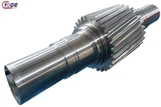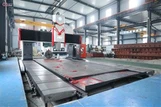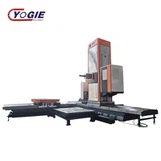Products Description

kiln tire
A kiln tire, also known as a riding ring or rolling ring, is a critical component in rotary kilns and similar industrial equipment used in processes like cement production, lime manufacturing, and various types of ore processing. Kiln tires are large cylindrical rings made of durable materials like cast steel or cast iron. They are positioned around the circumference of the kiln shell and play a crucial role in the functioning of the rotary kiln.
Products Description

features of kiln tire
Material: Kiln tires are typically made from high-strength materials like cast steel or cast iron. These materials provide the necessary durability to withstand the harsh operating conditions of rotary kilns, including high temperatures, mechanical stresses, and rotational forces.
Size: Kiln tires are quite large, with diameters ranging from several feet to tens of feet, depending on the size of the kiln they are designed for.
Shape: They have a cylindrical shape with a slightly conical surface that matches the inclination of the kiln shell. This shape allows them to maintain continuous contact with the kiln shell as it rotates.
Functions of kiln tires
Support and Rotation: One of the primary functions of kiln tires is to provide support for the heavy kiln shell and enable its smooth rotation. The tires bear the weight of the kiln shell and the material being processed inside it. They also ensure that the kiln shell rotates evenly and without wobbling, which is crucial for maintaining process efficiency and product quality.
Alignment: Kiln tires help maintain proper alignment of the kiln shell. Proper alignment is essential to prevent issues like uneven wear, excessive mechanical stresses, and potential damage to other components of the kiln.
Heat Transfer: Rotary kilns operate at high temperatures, and kiln tires are in direct contact with the kiln shell, which is exposed to extreme heat. The tires help in transferring heat away from the kiln shell, preventing excessive heat buildup that could lead to deformations or other structural issues.
Preventing Skewing: Kiln tires also play a role in preventing the kiln shell from skewing or deviating from its intended rotational axis. This is crucial for maintaining the uniform distribution of material inside the kiln and preventing uneven processing.
Wear Resistance: Kiln tires are designed to resist wear from continuous contact with the kiln shell. However, over time, some wear is inevitable due to the extreme operating conditions. Regular maintenance and inspections are essential to monitor and address any wear issues to ensure the kiln's safe and efficient operation.
machinery processing of kiln tire
Material Selection: Kiln tires are typically made from high-quality carbon steel or alloy steel. The choice of material depends on the specific requirements of the kiln and the manufacturing standards of the tire. The selected material is inspected for defects and impurities before processing.
Cutting and Shaping: The raw steel material is cut into the desired size and shape using cutting machinery like bandsaws or plasma cutting machines. The shape of the kiln tire is typically a ring with a slightly conical profile to match the kiln's curvature
Machining: Several machining operations are performed to refine the shape and dimensions of the kiln tire. These operations may include:
a. Turning: The outer and inner surfaces of the tire are turned on a lathe to achieve the required dimensions and a smooth finish.
b. Boring: If necessary, holes or bores may be drilled or machined into the tire for mounting on the kiln shaft.
c. Grinding: Precision grinding may be used to achieve a high level of dimensional accuracy and surface finish.
Heat Treatment: After machining, the kiln tire undergoes a heat treatment process to enhance its mechanical properties. This involves heating the tire to a specific temperature and then cooling it gradually. Heat treatment improves the tire's strength, durability, and resistance to wear and thermal stresses.
Quality Control: Quality control measures are implemented throughout the manufacturing process. This includes inspections of the raw material, dimensional checks after machining, and non-destructive testing to detect any internal defects. Ultrasonic testing, magnetic particle inspection, and dye penetrant testing are commonly used methods for quality assurance.
Finishing: After heat treatment and quality control checks, the kiln tire may undergo additional finishing processes, such as shot blasting or painting, to improve its surface finish and protect it from corrosion.
Assembly: Once the kiln tire is ready, it can be assembled onto the rotary kiln shaft. Proper alignment and installation are critical to ensure the smooth operation of the kiln.
Installation: The kiln tire is installed in its designated position on the rotary kiln, and it is often secured in place with retaining devices or bolts.
Ongoing Maintenance: Kiln tires are subject to wear and tear during operation. Regular maintenance and inspections are essential to monitor their condition and alignment, and worn or damaged tires may need to be replaced.
Summary
In summary, kiln tires are essential components of rotary kilns used in various industrial processes. They provide support, ensure proper rotation and alignment, assist in heat transfer, and contribute to the overall stability and longevity of the kiln system.
Hot Tags: kiln tire, manufacturers, supplier, factory, customized, cheap, price, in stock, for sale
















